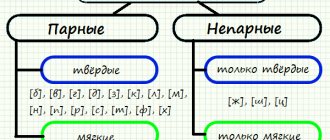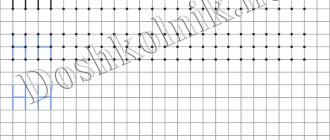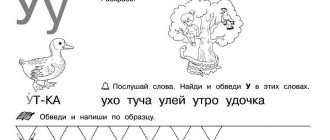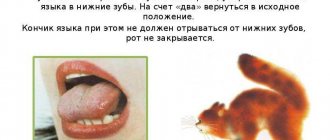Sound automation
Before starting speech correction, the speech therapist determines the cause of incorrect pronunciation, and then how to produce the sound[Z].
The first step towards improving diction is the method of imitation. In order for the child to visually control pronunciation, you can use a mirror. We recommend that parents practice first to make it easier to explain to the child what is required of him.
[Z] is paired in voicing with [S], as a result, all methods of setting [S] can be used for [Z]. That is, to get [Z] it is enough to add a voice when pronouncing.
The production of [Z] begins with automation [C].
Articulation gymnastics for the sound Z:
- Let's smile, open our mouth and make a slide with our tongue as for [C].
- Next we blow on the hill, little by little, including the voice.
If you have already managed to achieve a well-pronounced [S], then all that needs to be done to get the correct [Z] is to whistle loudly and loudly when pronouncing [S]. You can put your palm on the neck and check: with [C] the neck is very quiet, and with [Z] the bell rings.
Exercises for making the sound Z
You can automate sound in stages using exercises, starting with syllables and moving on to words and sentences.
Exercises should be chosen to be playful in nature, such as the poem “The Menagerie”. The teacher reads, and the children’s task is to finish the lines of poetry in rhyme. All words have the root “beast”.
Poem "Menagerie"
The second word repetition game. To do this, you need to prepare paired images. The teacher keeps one part for himself and distributes the rest to the children.
The game begins with the teacher taking a card and saying “I took an umbrella.” The one who has the umbrella in the pictures, showing, says, “And I have an umbrella.” Both cards are placed on the table. You can play like this until all the images are sorted into pairs.
The teacher’s task in this game is to monitor the clear and sonorous pronunciation of the sound [Z].
Why can't children pronounce the sound Z?
One of the most common problems in pronunciation is the sound Z. Experts classify it as a whistling sound. There are kids who simply pronounce a difficult sound incorrectly and at the same time have a funny lisp, and there are also those who ignore the problematic sound in words.
In childhood, the child’s articulatory apparatus is not sufficiently developed. When a baby learns to speak, he independently determines the pronunciation of certain sounds. Later, the process of mechanical memory starts and it can be very difficult to relearn how to speak correctly.
Often, parents scold the child and teach them to pronounce words correctly, using the standard repetition technique. For example, you can hear your mother say: “Say fairy tale, umbrella, ash.” This approach is wrong.
The baby will speak as he is used to, and not as his mother shows. For correct speech production, sessions with a speech therapist are necessary.
He will show where the tongue should be, select a set of exercises that will help consolidate what has been learned, and prescribe a course of articulatory gymnastics.
Setting the sound Ch
Sound G - production and automation
Sound Ш - how to set and automate
Sounds L and R – production and automation
Teaching a child to pronounce “dr-tr”
Literacy lesson on the topic “Consonant sounds [з, з]. Letters Z, z"
Literacy lesson.
Lesson summary on the topic “Sounds [z], [z']. Letter 3, z".
Goal: familiarize students with the sounds [з] and [з'] and the letter Zз, practice reading skills, expand vocabulary.
Lesson type: lesson in acquiring new knowledge.
During the classes:
- Organizing time.
- Setting goals and objectives.
Now I will tell you a few words. Listen carefully and tell me what is the first sound in these words?
Words: Frost, mayonnaise.
Which letter gives us the sound [m]?
Letter Mm.
Name 5 words with this letter.
Now listen to these two words again and tell me what sound these words end with?
Right. What sounds do you think we will talk about today?
About the sound [z].
Can anyone guess which letter makes the sound [z]?
Let's formulate together the topic of our lesson today: “Sounds [з], [з']. Letter 3, z".
What will we learn in class?
We will learn to write the letter Zz, and we will also find out what animals live in the zoo.
- Primary assimilation of new knowledge.
Let's open the textbooks on page 91. And read the topic of our lesson again. Let's think and say, is the sound [z] a vowel or a consonant? Can we stretch out this sound? No, it means the sound is consonant. Is he voiced or deaf? Say the sound [z] out loud. Loud, of course, like a bell ringing.
Our sound [z] is consonant and sonorous. Now let's think about whether it is always hard, or can it be both soft and hard? To do this, let's read the words:
Acquaintances, introduced, say, rang, bell, winter, turned green.
In all these words, is the sound [z] hard? Of course not. Let's say the words again: winter, green. This means there are sounds [z] and [z'].
And both of these sounds are made by one letter. Letter Zz.
Let's open our notebooks and write down the letter Zz. First, let's write the letter in the air. “On the working line we make a hook similar to the number 2, bring it to the bottom line of the working line, then write out the bottom loop, bringing it to the bottom additional line.”
- Initial check of understanding.
Now let's go back to the textbook and look at the diagrams. Let's look at them.
Snake, basket.
Let's pronounce each sound in the first word: Snake. Z-m'e-y. Let's look at the second diagram. Let's pronounce the word syllable by syllable: kor-zi-na. The word has 3 syllables because it has 3 vowels. Let's pay attention to which syllable the stress falls on? Basket.
Let's read the syllables: for, zo, zu, zy. Z is hard because there are vowels: a, o, u, y. And now the syllables zi, ze. In this case, the letters after the letter z soften it.
Now pause the video. And read these syllables yourself.
- Primary consolidation. Reading.
And now I’ll tell you a riddle, and you guess who we’re talking about?
In the grass by the river
The ring lies -
Ring with poison
With a cold look.
Snake.
Where can you and I see a snake? In the forest, by the river, in the zoo.
Have you gone to the zoo? What animals did you see there?
Let's open our textbook on page 95. And read the text and find out what animals live in the zoo?
I'll read first, and you follow.
Now stop the video and read the text yourself.
Now tell me, what animals live in the zoo, what animals were discussed in the text?
Lion, elephant, catfish, snake.
Now let's read the words. They put their fingers up. I read and you repeat after me.
Wind, umbrella, Zina, goat, basket, cabbage.
Which of these words contain the letter Zz. Say these words: umbrella, Zina, goat, basket. Now tell me in which words the letters Zz give a soft sound: Zina, basket. What about hard? Umbrella, goat.
- Reflection.
Where have we been today? What letters and sounds are you familiar with? Tell us everything you learned about the letter z? Were we able to achieve the goals we set at the beginning of the lesson?
- Information about homework, instructions on how to complete it.
Homework: In the copybook you write the letter Zz and syllables. And once again, independently read the text “Beasts in the Zoo” on page 95 of the textbook.
Techniques for teaching sound pronunciation
In order to establish the correct pronunciation of sounds, the speech therapist carries out labor-intensive work. First, it is necessary to record the correct movements of the organs of the articulatory apparatus.
Next, you should consolidate the results obtained with exercises. When the sound “goes”, it should be trained not only in classes with a speech therapist, but also at home. To get results, parents should monitor the pronunciation of words with problematic sounds in everyday speech.
Sound production is divided into several stages:
Articulation gymnastics. A speech therapist uses various exercises to develop the speech apparatus. To pronounce correctly, you need to prepare a platform and do gymnastics before each lesson. This will allow you to better understand future exercises.
It is recommended to conduct classes continuously every day in the morning;
Sound production. There are children who can pronounce whistling sounds correctly by the age of 4. They only need to consolidate their skills in practice. And there are those who are just learning to “whistle.”
Automation. At this stage, the child, with the help of special exercises, brings the result to perfection through constant repetition.







